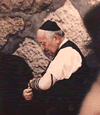Simon Wiesenthal Center: Repairing the World One Step at a Time

[Reprinted from the Simon Wiesenthal Center website at www.wiesenthal.com]
The Simon Wiesenthal Center is an international Jewish human rights organization dedicated to repairing the world one step at a time. The Center’s multifaceted mission generates changes through the Snider Social Action Institute and education by confronting antisemitism, hate and terrorism, promoting human rights and dignity, standing with Israel, defending the safety of Jews worldwide, and teaching the lessons of the Holocaust for future generations. With a constituency of over 400,000 households in the United States, it is accredited as an NGO at international organizations including the United Nations, UNESCO, and the Council of Europe. Headquartered in Los Angeles, the Simon Wiesenthal Center maintains offices in New York, Toronto, Palm Beach, Paris Buenos Aires and Jerusalem.[Reprinted from From the Simon Wiesenthal Web site at www.wiesenthal.com]
- Tools for Tolerance – an all-day program that utilizes the Museum’s unique educational environment to explore issues of diversity and tolerance, as well as cooperation in the workplace and in the community. To date, the Museum has trained over 100,000 professionals, including educators and, in partnership with the State of California, individuals in law enforcement. Additionally, the program accommodates firefighters, social workers, health care professionals, attorneys, probation officers, and others.
- Teaching Steps to Tolerance – the Museum’s national program is designed for 5th and 6th grade educators and library media specialists to integrate the teaching of tolerance into their school’s curriculum.
- Task Force Against Hate – confronts extremism by developing strategies to combat Holocaust denial and to educate students about antisemitism and bigotry through conferences and training sessions held throughout the country.
- National Institute Against Hate Crimes – The Center, with support from the US Department of Justice and the Bureau of Justice Assistance, trains criminal justice professionals.
- Tools for Tolerance for Teens – reaches thousands of middle and high school students while Steps to Tolerance engages over 6,000 fifth and sixth graders each year. For those who are not able to experience the Museum directly, Bridging the Gap reaches young people across the country through videoconferencing.
In 1967 Simon Wiesenthal published his memoirs, The Murderers Among Us. While promoting the book in America, he announced the finding of Mrs. Hermine Ryan, nee Braunsteiner, who lived in Queens, New York. According to the dossier, she had supervised the killings of several hundred children. She was extradited to Germany for trial as a war criminal and received life imprisonment.
Another of his priority cases was Karl Silberbauer, the Gestapo officer who arrested Anne Frank, the celebrated author of the famous The Diary of Anne Frank, who was murdered by the Nazis after hiding in a Amsterdam attic for two years.
When asked about his motives for becoming a Nazi hunter, Wiesenthal stated that he believed in life after death and when he came face to face with the millions of Jews who died in concentration camps he would say to them
"I did not forget you."

READ MORE
| The Simon Wiesenthal Center | Click here to visit site |
| Museum of Tolerance | Click here to visit site |
Labels: Diversity





0 Comments:
Post a Comment
<< Home